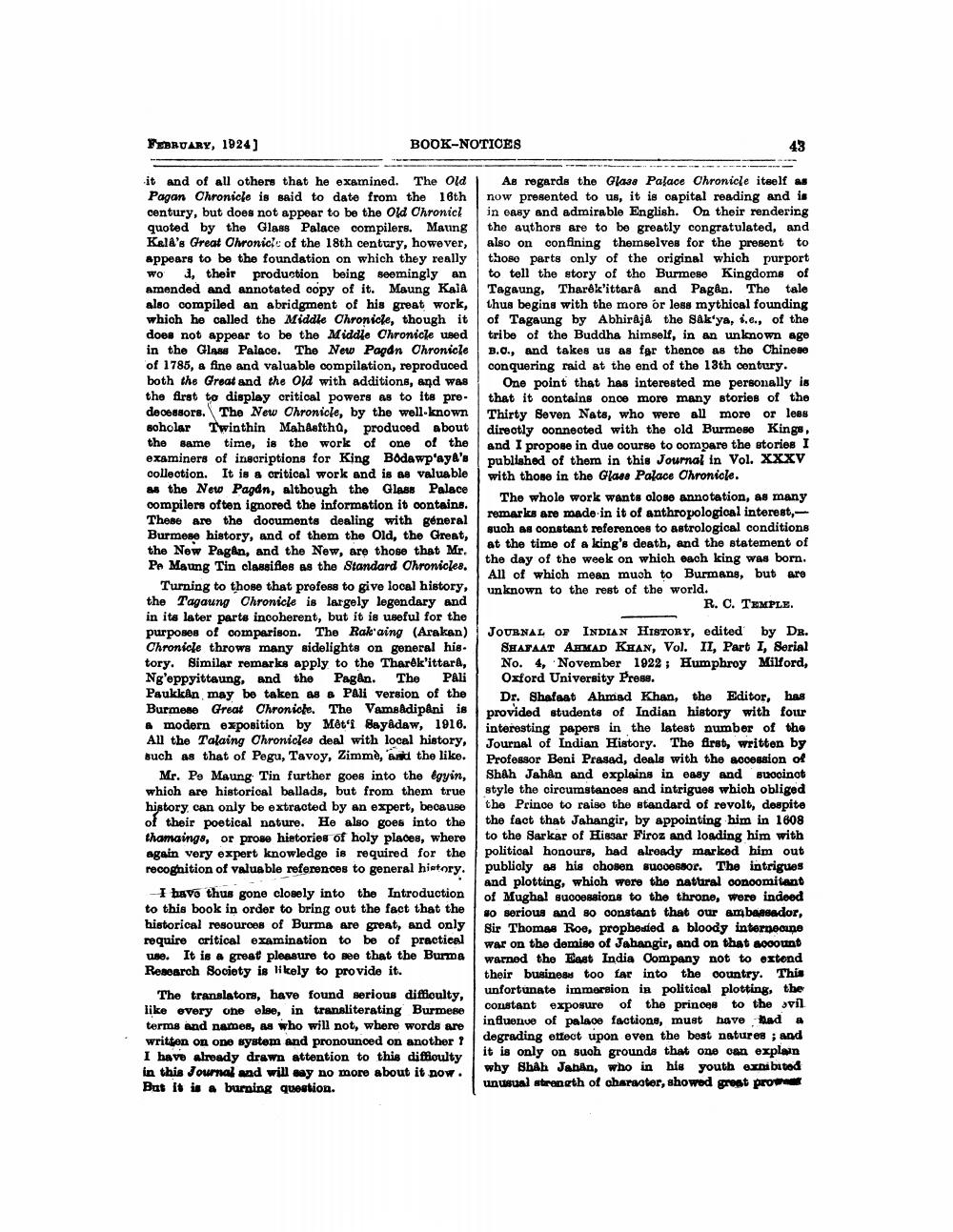________________
FEBRUARY, 1924)
BOOK-NOTICES
43
it and of all others that he examined. The Old As regards the Glass Palace Chronicle itself as Pagan Chronicle is said to date from the 16th now presented to us, it is capital reading and is century, but does not appear to be the Old Chronicl in casy and admirable English. On their rendering quoted by the Glass Palace compilers. Maung the authors are to be greatly congratulated, and Kald's Great Chronicle of the 18th century, however, also on confining themselves for the present to appears to be the foundation on which they really those parts only of the original which purport Wod, their production being seemingly an to tell the story of the Burmese Kingdoms of Amended and annotated copy of it. Maung Kaia Tagaung, Tharék'ittard and Pagên. The tale also compiled an abridgment of his great work, thus begins with the more or less mythical founding which he called the Middle Chronicle, though it of Tagaung by Abhiraja the sak'ya, .c., of the does not appear to be the Middle Chronicle used tribe of the Buddha himself, in an unknown age in the Glass Palace. The New Pagdn Chronicle B.O., and takes us as før thence as the Chinese of 1785, a fine and valuable compilation, reproduced conquering raid at the end of the 13th century. both the Great and the Old with additions, and was One point that has interested me personally is the first to display critical powers as to its pre. that it contains once more many stories of the decessors. The New Chronicle, by the well-known Thirty Seven Nats, who were all more or less scholar Twinthin Mahasftha, produced about directly oonnected with the old Burmese Kings, the same time, is the work of one of the
and I propose in due course to compare the stories I examiners of inscriptions for King Bodawp'aya's published of them in this Journal in Vol. AAAY
Lection. I 18 a critical work and 15 88 Valuable with those in the Glass Palace Ohronicle. ss the New Pagdn, although the Glass Palace
The whole work wants olose annotation, as many oompilers often ignored the information it oontains.
remarks are made in it of anthropological interest, These are the doouments dealing with general Burmese history, and of them the Old, the Great,
such as constant references to astrological conditions the New Pagên, and the New, are those that Mr.
at the time of a ling's death, and the statement of Pe Maung Tin classifies as the Standard Chronicles.
the day of the week on which each king was born.
All of which mean much to Burmang, but are Turning to those that profess to give local history,
unknown to the rest of the world. the Tagaung Chronicle is largely legendary and
R. C. TEMPLE. in its later parte incoherent, but it is useful for the purposes of comparison. The Rak aing (Arakan) JOURNAL OF INDIAN HISTORY, edited by Dr. Chronicle throws many sidelights on general his. | SHAFAAT AHMAD KIAN, Vol. II, Part I, Serial tory. Similar remarks apply to the Tharék'ittara, No. 4, November 1922; Humphroy Milford, Ng'eppyittaung, and the Pagan. The Pali Oxford University Press. Paukkan may be taken as & PAli version of the Dr. Shafaat Ahmad Khan, the Editor, has Burmese Great Ohronione. The Vamsadipini 18 provided students of Indian history with four & modern exposition by Mêt'i Sayadaw, 1916.
interesting papers in the latest number of the All the Talaing Chronicles deal with local history,
Journal of Indian History. The first, written by buch as that of Pegu, Tavoy, Zimme, end the like. Professor Beni Prasad, deals with the accession of
Mr. P. Maung Tin further goes into the bgyin, Shah Jahan and explains in easy and succinot which are historical ballads, but from them true style the circumstances and intrigues which obliged history, can only be extracted by an expert, because the Prince to raise the standard of revolt, despite of their poetical nature. He also goes into the the fact that Jahangir, by appointing him in 1608 thamaings, or prose histories of holy places, where to the Sarkar of Hissar Firoz and loading him with again very expert knowledge is required for the political honours, had already marked him out recognition of valuable references to general history. publicly as his chosen successor. The intrigues
and plotting, which were the natural conoomitant I havo thus gone closely into the Introduction
of Mughal suooessions to the throne, were indeed to this book in order to bring out the fact that the
do serious and so oonstant that our ambasador, historical resources of Burma are great, and only
Sir Thomas Roo, propbesed a bloody internecine require critical examination to be of practical
war on the demise of Jahangir, and on that socount use. It is a great pleasure to be that the Burma
warned the East India Company not to extond Research Society is likely to provide it.
their business too far into the country. This The translators, have found serious diffoulty,
unfortunate immersion in political plotting, the like every one else, in transliterating Burmese
constant exposure of the princes to the vil terms and names, as who will not, where words are
influence of palace factions, must have had a written on one system and pronounced on another?
degrading etteot upon even the best natures ; and I have already drawn attention to this diffioulty
it is only on such grounds that one can explain in this Journal and will say no more about it now.
why Shah Jahan, who in his youth exhibited But it is a burning question.
unusual strength of character, showed great protect




